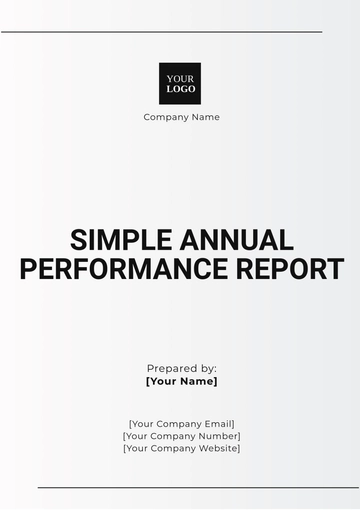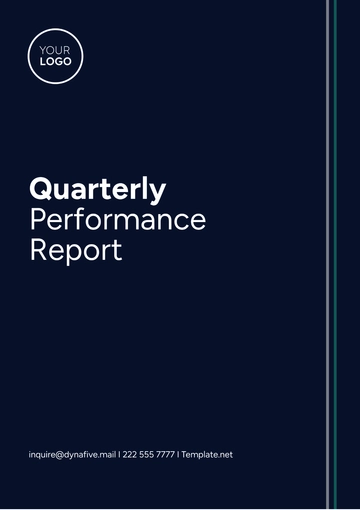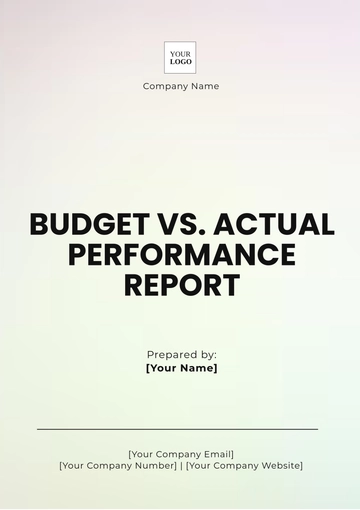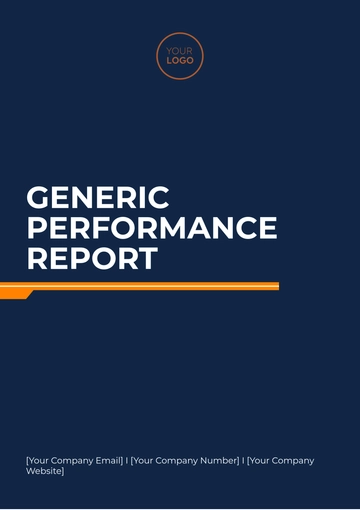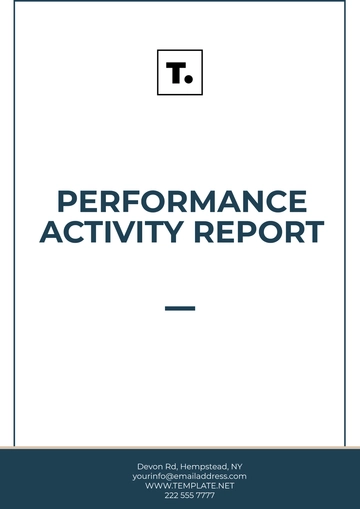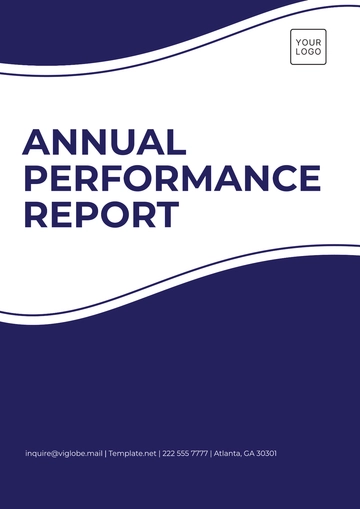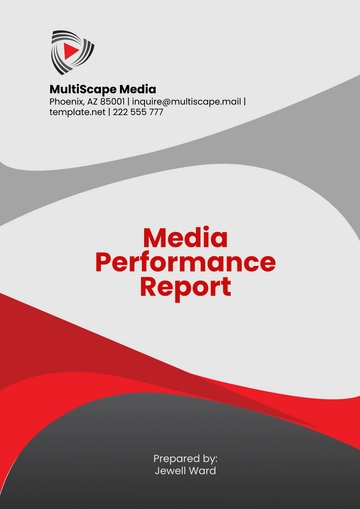Free Video Marketing Performance Report

Executive Summary
In this report, we present the comprehensive analysis of our recent video marketing campaign conducted from January 2055 to May 2055. Key findings reveal impressive performance metrics: 10 million video views, a 350% return on investment (ROI), and strong engagement metrics with an average 5% engagement rate. Recommendations include investing in high-quality video production, exploring emerging platforms, and leveraging influencer partnerships for further expansion.
Key Findings
The video marketing campaign has generated a total of 10 million video views.
Our videos received an average of 500,000 likes, 250,000 shares, and 100,000 comments per video.
The conversion metrics were impressive, with 20,000 leads generated and an estimated $5 million in direct sales.
The overall ROI for the video marketing campaign is an outstanding 350%.
Recommendations
Continue to invest in high-quality video production.
Consider expanding the video campaign to emerging platforms.
Explore partnerships with influencers to broaden our reach.
I. Introduction
Purpose of the Report
This Marketing Video Performance Report provides an analysis of our video marketing campaign's performance. It seeks to offer insights into the effectiveness of our video content, distribution channels, and budget allocation.
Scope of Analysis
The analysis covers the period from January 1, 2055, to May 31, 2055, focusing on our video marketing efforts across various platforms.
Methodology
Data for this report was collected using advanced AI analytics tools, encompassing real-time data, user behavior, and interactions with our video content.
II. Key Performance Indicators (KPIs)
KPIs are critical metrics used to evaluate the success of a video marketing campaign. They include factors like video views, engagement metrics (likes, shares, comments), conversion metrics (leads generated, sales influenced), and return on investment (ROI). KPIs help us measure the impact and effectiveness of our marketing efforts, guiding decision-making and strategic adjustments.
KPI | Metric | Value |
Video Views | Total views | 10,000,000 |
Average view duration | 1 min 30 sec | |
Breakdown by platform (YouTube, Metaverse, VR) | 60%, 25%, 15% | |
Engagement Metrics | Total likes, shares, comments | 500,000 likes, 250,000 shares, 100,000 comments |
Engagement rate | 5% | |
Click-through rate (CTR) | 2.5% | |
Conversion Metrics | Leads generated | 20,000 |
Sales influenced | $5,000,000 | |
Conversion rate | 4% | |
Return on Investment (ROI) | Total budget spent | $1,428,000 |
Revenue generated | $5,000,000 | |
ROI calculation | 350% |
III. Video Content Analysis
Video content analysis involves assessing the performance, themes, and types of videos in a marketing campaign. This analysis helps in understanding which videos resonate most with the audience, the engagement rates, and the impact of the content's themes and topics. Insights from video content analysis can guide content creation and strategy.
A. Content Overview:
Total number of videos published: 20
Types of videos: Educational (40%), Promotional (30%), Entertainment (30%)
Video themes and topics: Futuristic Technology, Sustainable Living, Space Exploration
B. Performance by Video:
Video Title | Total Views | Total Likes | Engagement Rate |
"Exploring Mars in VR" | 2,000,000 | 100,000 | 7% |
"Sustainable Living in 2055" | 1,500,000 | 100,000 | 6.5% |
C. Audience Insights:
Age demographics: 18-34 (60%), 35-54 (35%), 55+ (5%)
Gender distribution: Male (55%), Female (45%)
Geographical location: North America (50%), Europe (30%), Asia (15%), Other (5%)
D. Content Engagement:
VR experiences and educational content received the highest engagement.
Effective use of calls-to-action to prompt user engagement.
IV. Distribution Channels
Distribution channels refer to the platforms or outlets where video content is shared and promoted. This analysis explores how well the content performs on various platforms such as YouTube, social media, VR platforms, or emerging channels. It also delves into the geographic reach of the campaign and the demographics of the audience on different channels.
A. Channel Performance:
YouTube: 6 million views
Metaverse Platforms: 2.5 million views
Virtual Reality (VR) Platforms: 1.5 million views
B. Geographic Reach:
Our videos had the most impact in North America and Europe.
C. Audience Demographics:
Platform | Age Demographics | Gender Distribution | Geographic Location |
YouTube | 18-34 (50%) 35-54 (45%) 55+ (5%) | Male (60%) Female (40%) | North America (40%) Europe (35%) Asia (15%) Other (10%) |
Metaverse Platforms | 18-34 (70%) 35-54 (25%) 55+ (5%) | Male (70%) Female (30%) | North America (45%) Europe (35%) Asia (15%) Other (5%) |
VR Platforms | 18-34 (65%) 35-54 (30%) 55+ (5%) | Male (60%) Female (40%) | North America (40%) Europe (40%) Asia (15%) Other (5%) |
V. Competitive Analysis
Competitive analysis involves evaluating the performance of your video marketing campaign in comparison to key competitors in your industry. It includes examining metrics like video views, engagement, conversion rates, and ROI. This analysis provides insights into the strengths and weaknesses of your campaign relative to competitors, helping identify areas for improvement and innovation.
Key Competitors:
Key competitors in the industry included [Competitor A], [Competitor B], and [Competitor C].
Comparative Metrics:
Metric | Our Campaign | Competitor A | Competitor B | Competitor C |
Video Views | 10,000,000 | ___________ | _________ | _________ |
Engagement Rate | 5% | ___________ | _________ | _________ |
Conversion Rate | 4% | ___________ | _________ | _________ |
ROI | 350% | ___________ | _________ | _________ |
VI. Budget Allocation and ROI
This analysis focuses on the budget allocation for the video marketing campaign. It breaks down how the budget was distributed among various elements, such as video production, advertising, and influencer collaborations. Additionally, it calculates the ROI, which measures the campaign's profitability by comparing the costs incurred to the revenue generated.
A. Budget Overview:
Video Production: $600,000
Advertising and Promotion: $700,000
Influencer Collaborations: $128,000
B. ROI Calculation:
Total budget spent: $1,428,000
Revenue generated: $5,000,000
ROI: 350%
C. Recommendations for Budget Allocation:
Continue to invest in high-quality video production.
Allocate more budget for influencer collaborations.
Consider expanding advertising efforts on emerging platforms.
VII. Future Strategy
Future strategy outlines the goals, objectives, and plans for the upcoming video marketing campaigns. It involves setting specific targets, such as increased views or a higher ROI, and defining the strategies and tactics to achieve these objectives. This section also considers adjustments in content creation, platform selection, and budget allocation based on the insights gathered from the analysis of past campaigns. It aims to keep the marketing efforts aligned with evolving trends and technologies.
A. Goals and Objectives:
Goal: Reach 20 million views and achieve a 400% ROI in the next campaign.
Objectives: Expand to new emerging platforms and further diversify content.
B. Strategy Adjustments:
Invest in more immersive VR experiences.
Collaborate with a wider range of influencers.
Explore opportunities in the Metaverse and the emerging 6G network.
C. New Opportunities:
Investigate opportunities in AI-generated content.
Stay updated with the latest technologies and trends in marketing.
Conclusion
This Marketing Video Performance Report showcases the outstanding performance of our video marketing campaign. The data, insights, and recommendations provided should serve as a valuable reference for future marketing endeavors, ensuring that we maintain a competitive edge in this dynamic and tech-driven landscape.
For any questions or further analysis, please contact [Your Name] at [Your Email].
- 100% Customizable, free editor
- Access 1 Million+ Templates, photo’s & graphics
- Download or share as a template
- Click and replace photos, graphics, text, backgrounds
- Resize, crop, AI write & more
- Access advanced editor
Maximize your video marketing impact with Template.net's Video Marketing Performance Report Template. This editable and customizable tool provides insights into campaign effectiveness, audience engagement, and ROI. Seamlessly edit in our Ai Editor Tool to tailor analysis to your goals. Elevate your video strategy and optimize results effortlessly.
You may also like
- Sales Report
- Daily Report
- Project Report
- Business Report
- Weekly Report
- Incident Report
- Annual Report
- Report Layout
- Report Design
- Progress Report
- Marketing Report
- Company Report
- Monthly Report
- Audit Report
- Status Report
- School Report
- Reports Hr
- Management Report
- Project Status Report
- Handover Report
- Health And Safety Report
- Restaurant Report
- Construction Report
- Research Report
- Evaluation Report
- Investigation Report
- Employee Report
- Advertising Report
- Weekly Status Report
- Project Management Report
- Finance Report
- Service Report
- Technical Report
- Meeting Report
- Quarterly Report
- Inspection Report
- Medical Report
- Test Report
- Summary Report
- Inventory Report
- Valuation Report
- Operations Report
- Payroll Report
- Training Report
- Job Report
- Case Report
- Performance Report
- Board Report
- Internal Audit Report
- Student Report
- Monthly Management Report
- Small Business Report
- Accident Report
- Call Center Report
- Activity Report
- IT and Software Report
- Internship Report
- Visit Report
- Product Report
- Book Report
- Property Report
- Recruitment Report
- University Report
- Event Report
- SEO Report
- Conference Report
- Narrative Report
- Nursing Home Report
- Preschool Report
- Call Report
- Customer Report
- Employee Incident Report
- Accomplishment Report
- Social Media Report
- Work From Home Report
- Security Report
- Damage Report
- Quality Report
- Internal Report
- Nurse Report
- Real Estate Report
- Hotel Report
- Equipment Report
- Credit Report
- Field Report
- Non Profit Report
- Maintenance Report
- News Report
- Survey Report
- Executive Report
- Law Firm Report
- Advertising Agency Report
- Interior Design Report
- Travel Agency Report
- Stock Report
- Salon Report
- Bug Report
- Workplace Report
- Action Report
- Investor Report
- Cleaning Services Report
- Consulting Report
- Freelancer Report
- Site Visit Report
- Trip Report
- Classroom Observation Report
- Vehicle Report
- Final Report
- Software Report

